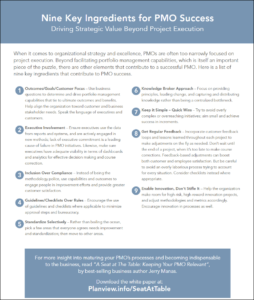
PMO success is no longer just about project execution. Today’s project and program management offices (PMOs) are tasked with driving strategic value to grow revenue along with improving the customer experience and products and services.
Instead of being narrowly focused on facilitating portfolio management capabilities, they must also strive to deliver on an organization’s most critical targets. By engaging effectively with the business and key stakeholders, they can drive value and maintain organizational strategy and excellence.
So, just what are the ingredients that contribute to a successful PMO? Here are four of nine examples from, “A Seat at The Table: Keeping Your PMO Relevant,” by best-selling business author Jerry Manas:
- Focus on Outcomes/Goals/Customers – Use business questions to help determine and drive portfolio management capabilities that tie to ultimate outcomes and benefits. This allows you to help align the organization toward customer and business stakeholder needs. It is important that you speak the language of both executives and customers.
- Executive Involvement – Lack of executive commitment is a leading cause of failure in PMO initiatives. It is essential that you ensure executives use the data from reports and systems, and are actively engaged in new methods. It is also critical to make sure executives have adequate visibility with dashboards and analytics for effective decision-making and course correction.
- Inclusion Over Compliance – Instead of being the methodology police, use capabilities and outcomes to engage people in improvement efforts and provide greater customer satisfaction. It will pay off in the long run.
- Guidelines/Checklists Over Rules – Encourage the use of guidelines and checklists where applicable to minimize approval steps and bureaucracy. Being too rule-heavy can slow down the process.
If you find this intriguing, we’ve created a cheat sheet that lists all Nine Key Ingredients for PMO Success.




